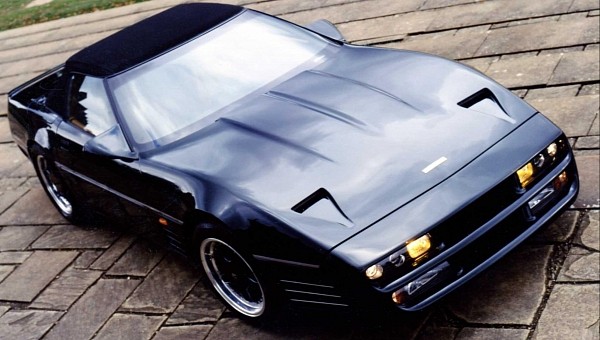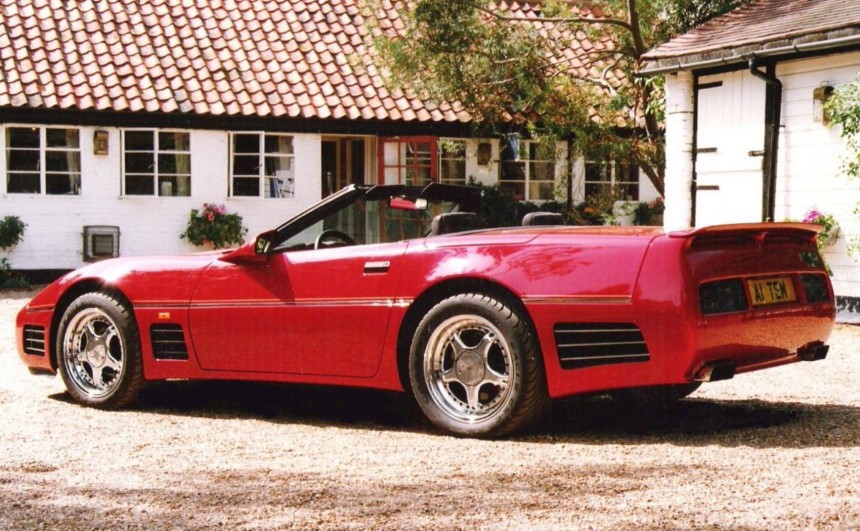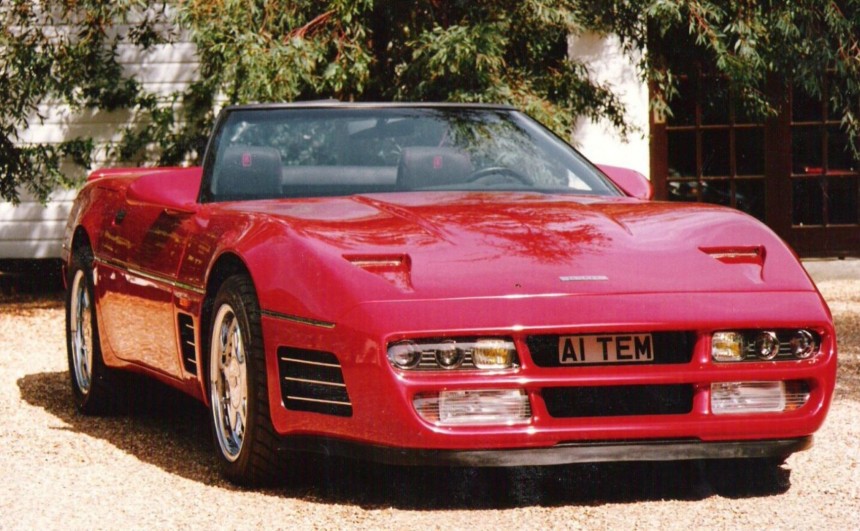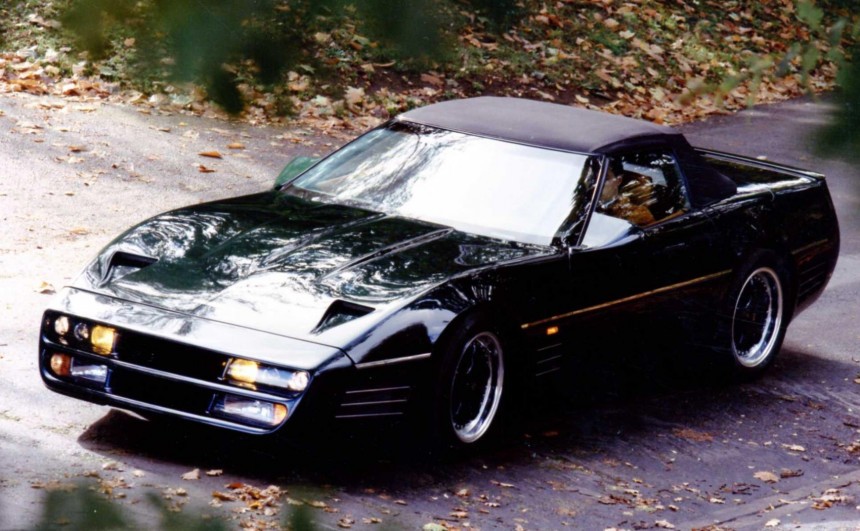Created by a company which made a name for itself for building ultra-expensive customs such as armored versions of Bentley and Rolls-Royce flagships, the coachbuilt Tempest was surprisingly well-mannered at cruising speeds and brutally fast when flooring the gas.
Unleashed on public roads forty years ago, the C4 was the first modern iteration of the Corvette. While it maintained the long nose and short rear deck styling of its predecessors, it introduced a host of innovations such as the so-called “uniframe” chassis and transverse mono-leaf springs on the front suspension.
At first, it was available with an underpowered small block but things improved in the years that followed. The pinnacle of performance came in 1990 when the ZR-1 was introduced. Powered by a marvelous Lotus-designed V8 dubbed LT5, it initially made 375 hp (380 ps) but by 1993, the output jumped to 405 hp (410 ps) thanks to several improvements.
In addition to the factory-built ZR-1, the fourth generation was transformed into a supercar killer by various tuners. Probably the most popular example was Callaway’s 880-hp (892 ps) SlegeHammer, a rocket on wheels that reached 254.76 mph (410 kph) 35 years ago.
But, apart from established American tuners who tweaked it to perfection, the C4 also became a thoroughbred supercar in the UK, thanks to a coachbuilder, which was not known for developing these types of cars.
Robert Jankel, the man behind this outrageous project, had a successful career in the fashion industry during the 1950s and 1960s, but he always had a soft spot for cars. In 1972, he decided to leave fashion behind and focus on his passion, founding a manufacturer called Panther Westwinds. Although he designed and built some interesting retro-inspired vehicles, Jankel’s brand didn’t do too well and, just five years later, it declared bankruptcy.
The English designer didn’t give up on his dream and founded a new company, Jankel Group, which specialized in ultra-luxurious customization of premium cars from the likes of Rolls-Royce, Bentley, or Mercedes-Benz – most tailored for celebrities and heads of state.
Apart from lavish armored limousines or 4x4s, Jankel ventured into the world of sports cars during the late 1980s, creating a turbocharged, Bentley-based grand tourer called Gold Label. It was meant to be a daily driver for the ultra-rich, but even those customers were hesitant to pay over $800,000 ($2,034,420 today) for the privilege of owning one.
To meet demand for a coachbuilt luxury sports car, Jankel needed something more “affordable.” So in 1990, he turned his attention to the convertible version of America’s favorite sports car, the C4 Corvette.
To make the latest ‘Vette appealing to his wealthy clientele, Jankel took it apart to its bare chassis and redesigned nearly everything. The new body panels were fabricated out of fiberglass and Kevlar, then experienced craftsmen fitted them onto the chassis by hand.
The front received a new hood with two NACA ducts that replaced the pop-up headlights, while the nose was completely reworked, housing new headlights and fog lights that flanked two ample grilles.
On each side, the new car dubbed Tempest received three sets of wide vents that aided brake ventilation. The first was located on the front bumper, in front of the wheel arch, the second stood behind the front wheel, whereas the third was integrated into the rear bumper, behind each wheel
At the rear, the Corvette’s four-taillight array that carried over from the previous generation was also redesigned. More conventional one-piece taillights were fitted, while a slim spoiler was added on top of the trunk lid.
Inside, the C4’s dashboard, steering wheel, and seats were retained, but everything was upholstered in high-end materials, which varied according to every individual customer’s choice. Some Tempests came with Alcantara, while others were covered in exotic hides such as faux ostrich.
A coachbuilt body and a luxury interior weren’t the only ingredients that Jankel used to cook up the Tempest. His recipe also included a custom-built V8 that transformed it into a record-breaking supercar.
Customers were able to order their cars with the original Chevy LT1 unit. It could be had in either naturally-aspirated, 300-hp (305 ps) form, or supercharged for an output increase of about 70 hp (71 ps).
However, those who wanted a truly bespoke Tempest could opt for a hand-built TRACO unit. Displacing 6.3 liters, this engine was based on a four-bolt competition Bowtie block equipped with forged internals and topped off with a Vortex supercharger.
The powerplant could spit out 537 hp (545 ps) and a mind-blowing 608 lb-ft (824 Nm) of torque, figures that made it far more potent than the Lotus-designed LT5 that powered the C4 ZR-1. Speaking of Lotus, the engine was mated to a ZF S6-40 six-speed manual, the same unit that was used in the Lotus Carlton high-performance sedan.
According to the British coachbuilder, the TRACO V8-powered supercar could sprint to 60 mph (97 kph) from a standstill in less than 3.3 seconds and reach a top speed of 200 mph (322 kph). Independent tests have shown that these figures were slightly exaggerated, but a Tempest was clocked at 3.89 seconds from 0 to 60 by Guinness representatives in 1991, earning it a spot in the Book of World Records as the quickest production car available at the time.
To cope with the added power, the Tempest’s chassis received bigger brakes and new dampers, which could be electronically adjusted by the driver via a console-mounted dial. Three settings were available: Touring, Sport, and Performance, the first of which made the powerful supercar surprisingly comfortable.
Moreover, the steering was light and precise, convincing journalists who got to test it that it was one of most predictable and easiest to drive supercars of the early 1990s, if the road was dry and the throttle was treated with respect. Most of them concluded that it was the ultimate daily driver and praised everything it had to offer.
Though no official figures exist, several sources cite that around 35 units were built from 1991 to 1993. Priced around $270,000 ($596,378 today) each, the cars were sold to customers in the Middle East. The sole exception was kept by Robert Jankel himself, who eventually sold it to a private buyer from the UK who still owns it today.
While it was never as outrageous as the Callaway SlegeHammer when it came to straight-line performance, the Jankel Tempest was a legitimate C4 Corvette-based supercar that excelled in more ways than one. Even if three decades have passed since the last one left the Jankel complex in Surrey, England, and few remember it ever existed, it remains one of the most fascinating vehicles, coachbuilt in the UK during the 1990s.
At first, it was available with an underpowered small block but things improved in the years that followed. The pinnacle of performance came in 1990 when the ZR-1 was introduced. Powered by a marvelous Lotus-designed V8 dubbed LT5, it initially made 375 hp (380 ps) but by 1993, the output jumped to 405 hp (410 ps) thanks to several improvements.
In addition to the factory-built ZR-1, the fourth generation was transformed into a supercar killer by various tuners. Probably the most popular example was Callaway’s 880-hp (892 ps) SlegeHammer, a rocket on wheels that reached 254.76 mph (410 kph) 35 years ago.
But, apart from established American tuners who tweaked it to perfection, the C4 also became a thoroughbred supercar in the UK, thanks to a coachbuilder, which was not known for developing these types of cars.
The idea behind the Tempest
The English designer didn’t give up on his dream and founded a new company, Jankel Group, which specialized in ultra-luxurious customization of premium cars from the likes of Rolls-Royce, Bentley, or Mercedes-Benz – most tailored for celebrities and heads of state.
Apart from lavish armored limousines or 4x4s, Jankel ventured into the world of sports cars during the late 1980s, creating a turbocharged, Bentley-based grand tourer called Gold Label. It was meant to be a daily driver for the ultra-rich, but even those customers were hesitant to pay over $800,000 ($2,034,420 today) for the privilege of owning one.
To meet demand for a coachbuilt luxury sports car, Jankel needed something more “affordable.” So in 1990, he turned his attention to the convertible version of America’s favorite sports car, the C4 Corvette.
A multitude of visual upgrades
The front received a new hood with two NACA ducts that replaced the pop-up headlights, while the nose was completely reworked, housing new headlights and fog lights that flanked two ample grilles.
On each side, the new car dubbed Tempest received three sets of wide vents that aided brake ventilation. The first was located on the front bumper, in front of the wheel arch, the second stood behind the front wheel, whereas the third was integrated into the rear bumper, behind each wheel
At the rear, the Corvette’s four-taillight array that carried over from the previous generation was also redesigned. More conventional one-piece taillights were fitted, while a slim spoiler was added on top of the trunk lid.
Inside, the C4’s dashboard, steering wheel, and seats were retained, but everything was upholstered in high-end materials, which varied according to every individual customer’s choice. Some Tempests came with Alcantara, while others were covered in exotic hides such as faux ostrich.
Powered by an amazing custom-built V8
Customers were able to order their cars with the original Chevy LT1 unit. It could be had in either naturally-aspirated, 300-hp (305 ps) form, or supercharged for an output increase of about 70 hp (71 ps).
However, those who wanted a truly bespoke Tempest could opt for a hand-built TRACO unit. Displacing 6.3 liters, this engine was based on a four-bolt competition Bowtie block equipped with forged internals and topped off with a Vortex supercharger.
The powerplant could spit out 537 hp (545 ps) and a mind-blowing 608 lb-ft (824 Nm) of torque, figures that made it far more potent than the Lotus-designed LT5 that powered the C4 ZR-1. Speaking of Lotus, the engine was mated to a ZF S6-40 six-speed manual, the same unit that was used in the Lotus Carlton high-performance sedan.
A record-breaking supercar meant to be daily-driven
To cope with the added power, the Tempest’s chassis received bigger brakes and new dampers, which could be electronically adjusted by the driver via a console-mounted dial. Three settings were available: Touring, Sport, and Performance, the first of which made the powerful supercar surprisingly comfortable.
Moreover, the steering was light and precise, convincing journalists who got to test it that it was one of most predictable and easiest to drive supercars of the early 1990s, if the road was dry and the throttle was treated with respect. Most of them concluded that it was the ultimate daily driver and praised everything it had to offer.
Though no official figures exist, several sources cite that around 35 units were built from 1991 to 1993. Priced around $270,000 ($596,378 today) each, the cars were sold to customers in the Middle East. The sole exception was kept by Robert Jankel himself, who eventually sold it to a private buyer from the UK who still owns it today.
While it was never as outrageous as the Callaway SlegeHammer when it came to straight-line performance, the Jankel Tempest was a legitimate C4 Corvette-based supercar that excelled in more ways than one. Even if three decades have passed since the last one left the Jankel complex in Surrey, England, and few remember it ever existed, it remains one of the most fascinating vehicles, coachbuilt in the UK during the 1990s.













